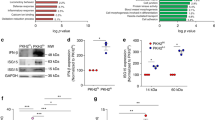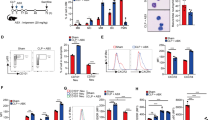Abstract
During the resolution phase of inflammation, the 'corpses' of apoptotic leukocytes are gradually cleared by macrophages. Here we report that during the resolution of peritonitis, the CCR5 chemokine receptor ligands CCL3 and CCL5 persisted in CCR5-deficient mice. CCR5 expression on apoptotic neutrophils and activated apoptotic T cells sequestered and effectively cleared CCL3 and CCL5 from sites of inflammation. CCR5 expression on late apoptotic human polymorphonuclear cells was downregulated by proinflammatory stimuli, including tumor necrosis factor, and was upregulated by 'proresolution' lipid mediators, including lipoxin A4, resolvin E1 and protectin D1. Our results suggest that CCR5+ apoptotic leukocytes act as 'terminators' of chemokine signaling during the resolution of inflammation.
This is a preview of subscription content, access via your institution
Access options
Subscribe to this journal
Receive 12 print issues and online access
$209.00 per year
only $17.42 per issue
Buy this article
- Purchase on Springer Link
- Instant access to full article PDF
Prices may be subject to local taxes which are calculated during checkout








Similar content being viewed by others
References
Majno, G & Joris, I. Cells, Tissues, and Disease: Principles of General Pathology (Oxford University Press, New York, 2004).
Serhan, C.N. Lipoxins and novel aspirin-triggered 15-epi-lipoxins (ATL): a jungle of cell-cell interactions or a therapeutic opportunity? Prostaglandins 53, 107–137 (1997).
Levy, B.D., Clish, C.B., Schmidt, B., Gronert, K. & Serhan, C.N. Lipid mediator class switching during acute inflammation: signals in resolution. Nat. Immunol. 2, 612–619 (2001).
Serhan, C.N. A search for endogenous mechanisms of anti-inflammation uncovers novel chemical mediators: missing links to resolution. Histochem. Cell Biol. 122, 305–321 (2004).
Rossi, A.G. & Haslett, C. in Proinflammatory and Antiinflammatory Peptides (ed. Said, S.I.) 9–24 (Marcel Dekker, New York, 1998).
Savill, J., Dransfield, I., Gregory, C. & Haslett, C. A blast from the past: clearance of apoptotic cells regulates immune responses. Nat. Rev. Immunol. 2, 965–975 (2002).
Gilroy, D.W. & Perretti, M. Aspirin and steroids: new mechanistic findings and avenues for drug discovery. Curr. Opin. Pharmacol. 5, 405–411 (2005).
Godson, C. et al. Cutting edge: lipoxins rapidly stimulate nonphlogistic phagocytosis of apoptotic neutrophils by monocyte-derived macrophages. J. Immunol. 164, 1663–1667 (2000).
Hanayama, R. et al. Identification of a factor that links apoptotic cells to phagocytes. Nature 417, 182–187 (2002).
Byrne, A. & Reen, D.J. Lipopolysaccharide induces rapid production of IL-10 by monocytes in the presence of apoptotic neutrophils. J. Immunol. 168, 1968–1977 (2002).
Savill, J., Hogg, N., Ren, Y. & Haslett, C. Thrombospondin cooperates with CD36 and the vitronectin receptor in macrophage recognition of neutrophils undergoing apoptosis. J. Clin. Invest. 90, 1513–1522 (1992).
Kim, S., Elkon, K.B. & Ma, X. Transcriptional suppression of interleukin-12 gene expression following phagocytosis of apoptotic cells. Immunity 21, 643–653 (2004).
Mitchell, S. et al. Lipoxins, aspirin-triggered epi-lipoxins, lipoxin stable analogues, and the resolution of inflammation: stimulation of macrophage phagocytosis of apoptotic neutrophils in vivo. J. Am. Soc. Nephrol. 13, 2497–2507 (2002).
Hanayama, R. et al. Autoimmune disease and impaired uptake of apoptotic cells in MFG-E8-deficient mice. Science 304, 1147–1150 (2004).
Aprahamian, T. et al. Impaired clearance of apoptotic cells promotes synergy between atherogenesis and autoimmune disease. J. Exp. Med. 199, 1121–1131 (2004).
Potter, P.K., Cortes-Hernandez, J., Quartier, P., Botto, M. & Walport, M.J. Lupus-prone mice have an abnormal response to thioglycolate and an impaired clearance of apoptotic cells. J. Immunol. 170, 3223–3232 (2003).
Bandeira-Melo, C. et al. Cyclooxygenase-2-derived prostaglandin E2 and lipoxin A4 accelerate resolution of allergic edema in Angiostrongylus costaricensis-infected rats: relationship with concurrent eosinophilia. J. Immunol. 164, 1029–1036 (2000).
Arita, M. et al. Stereochemical assignment, antiinflammatory properties, and receptor for the ω-3 lipid mediator resolvin E1. J. Exp. Med. 201, 713–722 (2005).
Ariel, A. et al. The docosatriene protectin D1 Is produced by TH2 skewing and promotes human T cell apoptosis via lipid raft clustering. J. Biol. Chem. 280, 43079–43086 (2005).
Bannenberg, G.L. et al. Molecular circuits of resolution: formation and actions of resolvins and protectins. J. Immunol. 174, 4345–4355 (2005).
Wahl, S.M., Swisher, J., McCartney-Francis, N. & Chen, W. TGF-β: the perpetrator of immune suppression by regulatory T cells and suicidal T cells. J. Leukoc. Biol. 76, 15–24 (2004).
Luster, A.D., Alon, R. & von Andrian, U.H. Immune cell migration in inflammation: present and future therapeutic targets. Nat. Immunol. 6, 1182–1190 (2005).
Strieter, R.M., Belperio, J.A., Phillips, R.J. & Keane, M.P. CXC chemokines in angiogenesis of cancer. Semin. Cancer Biol. 14, 195–200 (2004).
Oppermann, M. Chemokine receptor CCR5: insights into structure, function, and regulation. Cell. Signal. 16, 1201–1210 (2004).
Alkhatib, G. et al. CC CKR5: a RANTES, MIP-1α, MIP-1β receptor as a fusion cofactor for macrophage-tropic HIV-1. Science 272, 1955–1958 (1996).
Arur, S. et al. Annexin I is an endogenous ligand that mediates apoptotic cell engulfment. Dev. Cell 4, 587–598 (2003).
Hachicha, M., Pouliot, M., Petasis, N.A. & Serhan, C.N. Lipoxin (LX)A4 and aspirin-triggered 15-epi-LXA4 inhibit tumor necrosis factor 1α-initiated neutrophil responses and trafficking: regulators of a cytokine-chemokine axis. J. Exp. Med. 189, 1923–1930 (1999).
Huynh, M.L., Fadok, V.A. & Henson, P.M. Phosphatidylserine-dependent ingestion of apoptotic cells promotes TGF-β1 secretion and the resolution of inflammation. J. Clin. Invest. 109, 41–50 (2002).
Green, D. & Kroemer, G. The central executioners of apoptosis: caspases or mitochondria? Trends Cell Biol. 8, 267–271 (1998).
Rot, A. & von Andrian, U.H. Chemokines in innate and adaptive host defense: basic chemokinese grammar for immune cells. Annu. Rev. Immunol. 22, 891–928 (2004).
Proost, P. et al. Cleavage by CD26/dipeptidyl peptidase IV converts the chemokine LD78β into a most efficient monocyte attractant and CCR1 agonist. Blood 96, 1674–1680 (2000).
Guan, E., Wang, J., Roderiquez, G. & Norcross, M.A. Natural truncation of the chemokine MIP-1β/CCL4 affects receptor specificity but not anti-HIV-1 activity. J. Biol. Chem. 277, 32348–32352 (2002).
Oravecz, T. et al. Regulation of the receptor specificity and function of the chemokine RANTES (regulated on activation, normal T cell expressed and secreted) by dipeptidyl peptidase IV (CD26)-mediated cleavage. J. Exp. Med. 186, 1865–1872 (1997).
Jamieson, T. et al. The chemokine receptor D6 limits the inflammatory response in vivo. Nat. Immunol. 6, 403–411 (2005).
D'Amico, G. et al. Uncoupling of inflammatory chemokine receptors by IL-10: generation of functional decoys. Nat. Immunol. 1, 387–391 (2000).
Chan, A., Magnus, T. & Gold, R. Phagocytosis of apoptotic inflammatory cells by microglia and modulation by different cytokines: mechanism for removal of apoptotic cells in the inflamed nervous system. Glia 33, 87–95 (2001).
Tyner, J.W. et al. CCL5–CCR5 interaction provides antiapoptotic signals for macrophage survival during viral infection. Nat. Med. 11, 1180–1187 (2005).
Whyte, M.K., Meagher, L.C., MacDermot, J. & Haslett, C. Impairment of function in aging neutrophils is associated with apoptosis. J. Immunol. 150, 5124–5134 (1993).
Ness, T.L. et al. CCR1 and CC chemokine ligand 5 interactions exacerbate innate immune responses during sepsis. J. Immunol. 173, 6938–6948 (2004).
Heredia, A. et al. Rapamycin causes down-regulation of CCR5 and accumulation of anti-HIV β-chemokines: an approach to suppress R5 strains of HIV-1. Proc. Natl. Acad. Sci. USA 100, 10411–10416 (2003).
O'Shea, J.J., Ma, A. & Lipsky, P. Cytokines and autoimmunity. Nat. Rev. Immunol. 2, 37–45 (2002).
Serhan, C.N. et al. Design of lipoxin A4 stable analogs that block transmigration and adhesion of human neutrophils. Biochemistry 34, 14609–14615 (1995).
Brunetti, M. et al. Polymorphonuclear leukocyte apoptosis is inhibited by platelet-released mediators, role of TGFβ-1. Thromb. Haemost. 84, 478–483 (2000).
Chen, W. et al. Requirement for transforming growth factor β1 in controlling T cell apoptosis. J. Exp. Med. 194, 439–453 (2001).
Chen, W., Frank, M.E., Jin, W. & Wahl, S.M. TGF-β released by apoptotic T cells contributes to an immunosuppressive milieu. Immunity 14, 715–725 (2001).
Hebert, M.J., Takano, T., Holthofer, H. & Brady, H.R. Sequential morphologic events during apoptosis of human neutrophils. Modulation by lipoxygenase-derived eicosanoids. J. Immunol. 157, 3105–3115 (1996).
Serhan, C.N. et al. Anti-inflammatory actions of neuroprotectin D1/protectin D1 and its natural stereoisomers: assignments of dihydroxy-containing docosatrienes. J. Immunol. 176, 1848–1859 (2006).
Wysocki, C.A. et al. Differential roles for CCR5 expression on donor T cells during graft-versus-host disease based on pretransplant conditioning. J. Immunol. 173, 845–854 (2004).
Kuziel, W.A. et al. CCR5 deficiency is not protective in the early stages of atherogenesis in apoE knockout mice. Atherosclerosis 167, 25–32 (2003).
Kumar, S. et al. SMM-chemokines: a class of unnatural synthetic molecules as chemical probes of chemokine receptor biology and leads for therapeutic development. Chem. Biol. 13, 69–79 (2006).
Acknowledgements
We thank M.H. Small for assistance in manuscript preparation, and J. Deady for technical assistance. Supported by the US National Institutes of Health (GM38765, DK-074448 and P50-DE016191 to C.N.S., and DK-074449 to A.D.L.) and the Arthritis Foundation (A.A.).
Author information
Authors and Affiliations
Contributions
All authors were involved in experimental planning and data analysis and contributed to manuscript preparation. A.A. carried out FACS analysis, binding, chemotaxis, human cell isolation and cell culture; G.F. carried out experiments, FACS analysis, human cell isolation and culture; Y.-P.S. carried out peritonitis experiments and related analyses; A.K. and T.E.V.D. carried out Luminex analyses and related experimental design; A.D.L. carried out experiments with CCR5-deficient mice.
Corresponding author
Ethics declarations
Competing interests
C.N.S. is a consultant for the clinical development of lipoxin stable analogs with Berlex-Schering and for the development of Resolvin E1 with Resolvex Pharma.
Supplementary information
Supplementary Fig. 1
Ly-6G+F4/80+ in peritoneal exudates are PMN-macrophage conjugates. (PDF 170 kb)
Supplementary Fig. 2
Increased CCL4 binding to late apoptotic T cells. (PDF 219 kb)
Supplementary Fig. 3
Caspase inhibition abrogates apoptosis-induced modulation of CCL4 binding to late apoptotic T cells. (PDF 263 kb)
Supplementary Fig. 4
Scheme of the role of apoptotic leukocytes and pro-resolving lipid mediators in the resolution of inflammation. (PDF 412 kb)
Rights and permissions
About this article
Cite this article
Ariel, A., Fredman, G., Sun, YP. et al. Apoptotic neutrophils and T cells sequester chemokines during immune response resolution through modulation of CCR5 expression. Nat Immunol 7, 1209–1216 (2006). https://doi.org/10.1038/ni1392
Received:
Accepted:
Published:
Issue Date:
DOI: https://doi.org/10.1038/ni1392
This article is cited by
-
The critical role of apoptosis in mesenchymal stromal cell therapeutics and implications in homeostasis and normal tissue repair
Cellular & Molecular Immunology (2023)
-
Time-course RNA-seq analysis reveals stage-specific and melatonin-triggered gene expression patterns during the hair follicle growth cycle in Capra hircus
BMC Genomics (2022)
-
Cardiomyocyte IL-1R2 protects heart from ischemia/reperfusion injury by attenuating IL-17RA-mediated cardiomyocyte apoptosis
Cell Death & Disease (2022)
-
Role of specialized pro-resolving lipid mediators in pulmonary inflammation diseases: mechanisms and development
Respiratory Research (2021)
-
Regulatory mechanisms of neutrophil migration from the circulation to the airspace
Cellular and Molecular Life Sciences (2021)



